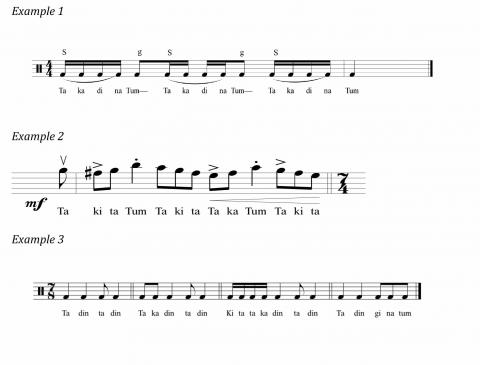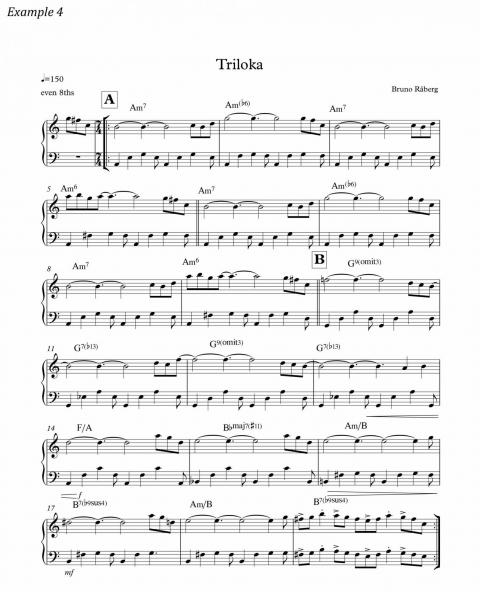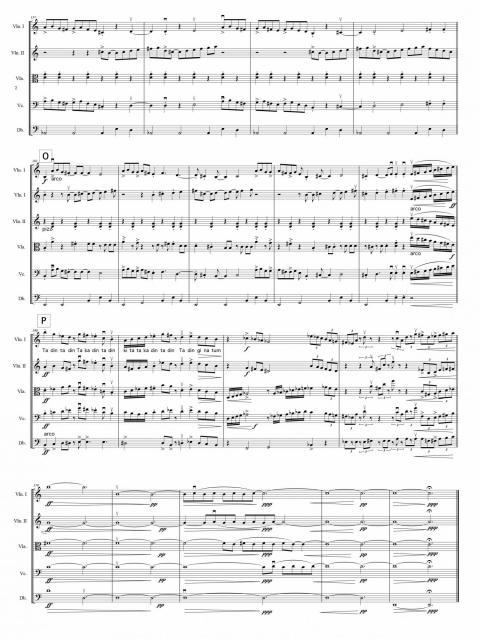The Woodshed: Composing with Carnatic Rhythmic Elements

In addition to his educational work, professor Bruno Raberg is an internationally renowned bassist and composer.
When I was a teenager, I first heard Indian sitar master Ravi Shankar and ever since, have been fascinated by the music of India. Guitarist John McLaughlin and his groups Mahavishnu Orchestra and Shakti, both of which I saw live several times, further spurred my interest in Indian music and connected with the jazz and fusion music I was listening to and playing during the 1970s. Much like the first time I heard John Coltrane’s Giant Steps album, Indian music startled my sense of curiosity. I wondered what was going on rhythmically, melodically, and in the form. I’m still in awe of how many different ways we humans have developed music around the globe and how music has survived throughout history. Below, I’ll discuss some Indian musical elements that I incorporated in my composition Triloka: Three Realms.
The Mora
The mora is a rhythmic structure in South Indian or Carnatic music. It’s a rhythmic, cadential phrase that can span just a few beats or be a long and complex structure that is part of the percussion solo or tani avartanam. The mora can be improvised or composed. The basic underlying structure is: statement—gap—statement—gap—statement, abbreviated as: s—g —s—g—s. The two gaps can comprise music or silence and must be identical in length. The statements have to be identical or follow a symmetric shape, however, there can be exceptions.
Example 1 on page 27 shows a very simple mora that spans four quarter notes. The statement is shown here using the mnemonic rhythm syllables: Ta ka di na (four sixteenth notes) and the gap (tum) has the value of an eighth note), The formula is 4+2+4+2+4.
The mora phrases usually resolve to beat one, called samam, in the next cycle. The mora can start anywhere in the cycle, and can also resolve to the starting note of the melody which is called Eduppu.
Applying the Mora
My piece for string orchestra, Triloka: Three Realms, was originally just a short composition in 7/4 in the jazz/world music vein (see example 4). The progression is based on five chords: Amin7, G7, F/A, B-flat maj7 and B min7, all with a variety of tensions. Let’s take a look at how I applied a mora structure at the very end of the piece to set up the repeat of the melody.
I used a mora with the following structure: S = 3, g = 2, S = 5, g = 2, S = 3 or 3-2-5-2-3. The variation of the statement 3 – 5 – 3 follows a symetrical structure of expansion and diminution. In Carnatic terms, it is called mridanga yati and outlines the barrel shape of the mridangam drum.
The phrase begins an eighth note before beat one and resolves to the downbeat in the next cycle. This is a really short mora that closes one section and sets up the next with a strong sense of forward motion (see example 2).
If we were to recite this line with Solkattu syllables, it would be: Ta | ki ta Tum – Ta ki ta Ta ka Tum – Ta ki ta |
Since Indian music is purely modal and does not have harmonic cadences, one could argue that the mora is a way of creating a rhythmic cadence that functions like a II-V-I progression in jazz.
New Rhythmic Realms
My piece is based on the 18-bar tune “Triloka” and was commissioned for the Berklee World Strings. In arranging it for strings, I ended up applying more complex moras and other structures. The meter or tala of the piece is based on a Carnatic tala cycle called misra chapu, a 7-beat cycle divided as 3+4 with claps on beats 1, 2, 4, and 6. (Visit berklee.edu/trilokalesson to hear the cycle.)
Let’s look at a structure that uses variations of a basic 7/8 motive: Ta ka di mi Ta ki ta, which is 4 + 3.
Here are four different variations on this basic pattern:
• Ta – din – ta din –
• Ta ka din – ta din –
• ki ta ta ka din – ta din –
• Ta – din – gi na tum
(Example 3 shows the patterns.)
Strung together, they will span two 7/4 cycles. For the audio clip (posted at berklee.edu/trilokalesson), I recited the misra chapu clapping pattern as I said the syllables. As you can hear, this pattern has a natural ebb and flow, which creates a cycle of tension and release.
This structure is employed as a rhythmic cadence in the coda in Triloka. (See example 5, measures 166-167.) It works as a transition between a longer complex structure to the final push of the piece.
The Final Cadence
In the final cadence, I freely weave together a series of overlapping moras and calculations (kannakku) to form the final extended push to the end.
Starting at rehearsal letter M, on beat 2, I apply a structure that is an expansion of the original motive: 3 2 3 4. We will call the first half (3 2) A, and the second half (3 4) B. The expanded structure that follows is AB | AABB | AAABBB, or 3234| 32323434 | 323232 343434. It spans five cycles of 7/4. In the final bar, I wanted a mora structure to lead in to the next cycle, so I created the mora 3 4 3 4 3, by deleting the final 4. (See bar 155.) The entire structure spans bars 151 through 155.
Conclusion
There is certainly a mathematical component to music, which provides symmetry. I’m a firm believer that beauty is inherent in symmetry whether it is John Coltrane’s harmonic structure in his tune “Giant Steps” or the complex rhythmic structures in Indian music. The symmetry provides the pillars upon which we can build and transmit the spirit, body, and soul of music. This article is just the tip of the iceberg of the vast complexities of Indian music and how they can be applied in composition. I hope it may inspire you to explore further.
Visit https://soundcloud.com/soundsofberklee/sets/bruno-raberg-composing-with for audio of musical examples.

https://soundcloud.com/soundsofberklee/misra-chapu-7-beat-cycle

https://soundcloud.com/soundsofberklee/triloka-lead-sheet-wtrio

Example 5: https://soundcloud.com/soundsofberklee/bruno-raberg-triloka-music-for-e…

Example 5b: https://soundcloud.com/soundsofberklee/bruno-raberg-triloka-full-score




